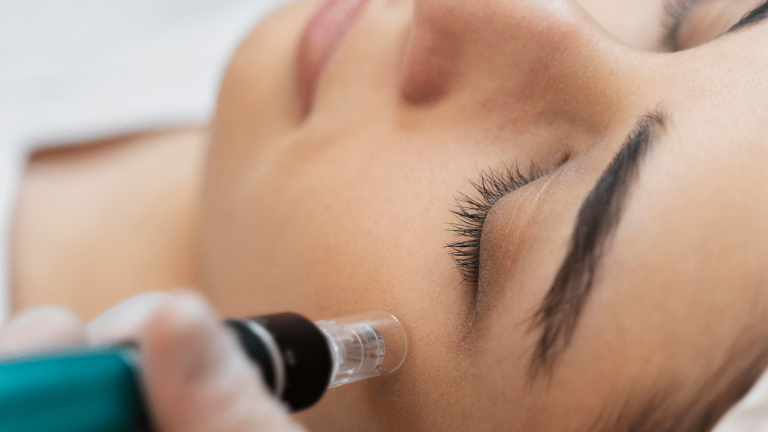Iit’s that time of year when the unforgiving sun keeps us inside. However, many patients come in complaining of sun tanning and try to correct it with certain types of facial treatments.
So let me break down the three main facials that people talk about almost interchangeably when they shouldn’t — medical facial, salon facial, and HydraFacial.
The brand that became popular
HydraFacial is a brand-name treatment known for its multi-step approach to facial rejuvenation. It is fairly non-invasive and involves a hydration method using a patented device.
HydraFacial is not a facial technique and should not be confused with one. Today, it has become very popular as you can see from your social media feeds. Many advertisements rely on the benefits of HydraFacial without really informing the reader/end user of its specifics.
While HydraFacials offer instant hydration, they may not deliver the same results as medical facials, especially when it comes to treating specific skin concerns. And if there’s one thing I’ve reiterated in my 13 years of experience, it’s this — skin care is a routine, so be careful before you go for the fastest way.
Read also: Glutathione injection can repair skin, reduce pigmentation. But it affects your kidneys
Facial care – the care process
Salon facials are skin care treatments offered in beauty salons, spas or wellness centers. They are usually performed by beauticians who specialize in skin care, but may not have medical training. Such treatments often incorporate standard skin care procedures using commercially available products.
However, since they don’t have the medical expertise, equipment and access to the same ingredients as dermatologists, they end up resorting to more readily available ingredients like bleach (fruit or oxygen bleach), chemicals and peels for an instant glow. which can be quite traumatic for your skin.
Salon facials also use steam and involve a lot of hand massage, which is not good for your skin. Hand massaging your face over time leads to faster skin relaxation and can even change the structure of your face.
While in-salon facials may offer some degree of customization, they generally follow a set regimen with predetermined protocols. Estheticians can recommend products and techniques based on a client’s skin type and concerns without having any clinical knowledge of the products and their implications.
I’ve noticed another very popular pattern among clients – many salons now offer HydraFacials, which when it comes down to it, is just the brand name and not an actual technique. Salons may call it a ‘HydraFacial’ but they may be using a cheaper alternative to the patented machine and in turn charging you full price.
HydraFacial equipment is a very expensive machine and while the treatment has become fashionable these days, it is not the industry leader. Do your research before opting for a major procedure of any kind on your skin.
Read also: Skin care routines start with discovering your skin type. Don’t rely on Instagram ads
Medical facials — the way to go
Medical facials, also known as clinical facials, are skin care treatments administered under the supervision of a licensed medical professional, such as a dermatologist or trained esthetician.
They are completely different from salon facials as they only use pure oxygen and mesoporation, a non-invasive skin rejuvenation technique that involves the use of electrical pulses to inject the required vitamins and serums into your skin. These may include vitamin C serums, ascorbic acid and kojic acid, which, in their safest forms, are ultimately responsible for skin whitening, hydration, antiaging, etc.
How does an ideal medical person work?
A medical facial involves four main steps.
Cleansing: Your dermatologist or esthetician will first thoroughly cleanse your skin to remove any make-up, dirt and oil from the surface. Cleansing ensures that the skin is free of any blockages that could hinder the effectiveness of the treatment. Additionally, your esthetician will wear gloves throughout and there will be almost zero hand-to-skin contact.
Microdermabrasion: This is basically exfoliation. It involves gently rotating diamond crystals using a machine on your skin to remove any dead skin.
Conductive gel application: The esthetician will then apply a conductive gel containing active ingredients such as hyaluronic acid and vitamins to your skin. This helps facilitate the transmission of the electrical impulses and enhances the penetration of the active ingredients into the deeper layers of your skin.
Mesoporosis: During this stage, a handheld device that emits low-frequency electrical pulses is gently massaged into the skin. These pulses create temporary nanopores in the skin’s lipid barrier, allowing for better absorption of the active ingredients. Legumes also promote collagen production, which can help improve skin texture and firmness.
Finally, depending on your skin type, the esthetician will apply a facial pack to soothe your skin, reduce any inflammation and give your skin a hydrated and healthy glow.
These steps are also present in the HydraFacial. But if you want to opt for a similar facial, skip the salon—ask your dermatologist about medical facials. Only your doctor will know what kind of ingredients should be injected into your skin based on factors such as age, skin type, smoking vs. non-smoking habits, lifestyle, etc.
Medical facials take a scientific approach to skin care. Dermatologists use only medically approved products and offer targeted solutions for issues such as acne, hyperpigmentation, fine lines and wrinkles. In addition, these techniques offer noticeable and long-lasting improvements in skin texture, tone and overall appearance.
In skin care, there are a number of treatments available – just make sure you know the ins and outs of them all before you commit.
Dr. Deepali Bhardwaj is a dermatologist, allergist, laser surgeon and internationally trained esthetician. He tweets @dermatdoc. Opinions are personal.
(Editing by Humra Laeeq)

